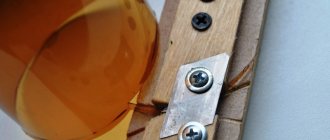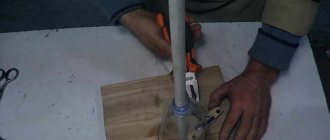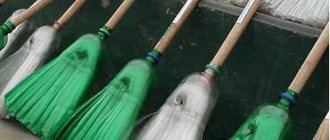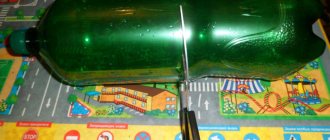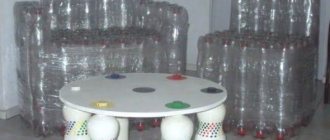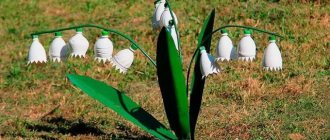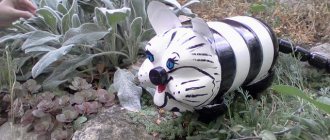Plastic tape made from plastic bottles is used in household farming. Thanks to it, you can strengthen a wooden fence or tie up berry bushes. This rope can withstand up to 50 kg. It depends on its thickness and length. It is mainly used as a fixative.
There are two ways to cut plastic bottles: manual and machine. You can make transparent tape yourself at home. To do this you will need sharp scissors and proper markings.
You must admit that producing such material manually is a rather labor-intensive process. A special device will help make cutting transparent tape easier.
What can a bottle cutting device be made from? What materials will be needed to build such a structure? The answers to these questions are presented in our article. Advice from experienced craftsmen will help you cope with the task.
Application of PET tape from bottles
Let's show an interesting use of PET bottle tapes by making a tube.
Heat with a construction hairdryer, passing through the narrowings under slight tension. If you use a hairdryer at full power, then in 10 hours of continuous operation, it will consume 60 rubles worth of electricity, if 3 rubles per kW. If you lightly hold the ends of the workpiece and heat it, it will curl. You will need to guide the tapering tape into a narrower passage so that the edges meet. All. Even if you pass the heated one through a hole in the board, you will get a tube. First I twisted a spring steel spiral for a diameter of 3 mm. There is nothing complicated about it, just the preparation. Attached to a hole in the board. For it, I cut the tape 12 mm wide, and there were a couple of holes in the board. I inserted a spiral into one, and screwed the neck of a bottle into the other for a skein to hold tension.
I threaded a ribbon through the neck and cut off the tip to fit into the spiral. Somehow I lost the spiral and made it out of aluminum. And it turned out to be a tube. Then, out of curiosity, he pulled the heated workpiece into the hole in the block.
The block is easy to get and prepare. It’s easy to burn a tube in a 1.5 mm coil, but you can’t burn it through a bar, since it doesn’t heat up behind it and cools quickly. If it's through it, it's harder to pull and you need to increase the tension.
We wrap a piece of fabric around the tape and insert it into the neck. We cut off the corner to fit into the hole of the block and create tubes. When you need to grab it with your hand, turn off the hair dryer and pull until it cools down.
First we will make it 2.5 mm in diameter from 9.5 mm tapes. Then by 2 mm from 7.5 mm. And by 1.5 mm out of 6 mm.
Master class on weaving a large shopping basket
Weaving from plastic bottles (the process of weaving from long ribbons is described step by step for beginners) allows you to create strong and reliable baskets that are useful for use on the farm. With them you can go to the forest to pick mushrooms, store vegetables and fruits in them, and put things away.
For a 7 liter basket, you will need 76 m of tape. It is advisable to cut strips from large containers to make strips 2 m long. There should be 36 pieces in total.
Further actions:
- Cut the ends of the ribbons at an angle. This will make the weaving process easier.
- Straighten 4 ribbons and place them on the floor. Using a felt-tip pen, mark their middle.
- From the central marks you need to put 2 more points, retreating from the middle to the sides by 15 cm. Then make the same marks, retreating from the previous points.
- On all other blanks, only the center needs to be marked.
- Weave a fabric measuring 18x18 strips using a checkerboard pattern.
- Fix the corners of the square with small drops of transparent Moment glue.
- Select any side of the fabric and fold it up. Start weaving the side wall.
- Weave a fabric measuring 9x9 strips. Secure the edges of the square with glue.
- Repeating steps 7 to 8, you need to weave the remaining walls of the basket.
- Turn the product upside down. Tighten the tapes in the corners so that there are no gaps.
- Use a measuring tape to measure the diagonal of the bottom. Check how even the weave is. If there are any shortcomings, they need to be carefully corrected.
- Turn the basket over. Weave 1 more circular row along the edges of the walls. Secure the joints with thread.
- The edges need to be woven so that they do not have sharp corners. Cut off the excess ribbons and pull them inside the weave.
- By analogy, close all side seams. It will be more difficult to make seams from the inside, so you can use pliers or large tweezers to pull the tapes through.
- To weave handles you will need 16 ribbons, 1 m in length.
- 2 ribbons need to be woven onto 2 walls of the basket from the outside.
- Weave 2 ribbons into the walls of the basket from the inside.
- Weave all the strips together in a circle.
- Once the shape of the handle is obtained, you need to stretch it to the opposite edge of the basket and make sure that its length is sufficient.
- Secure the edge of the handle to the other wall of the basket, weaving in the ends of the strips.
- For reliability, you need to lubricate the ends of the handle with plastic glue. Then the handle will be even stronger and will not come off.
- To make the handle more rigid, you need to additionally weave 8 more plastic strips into it.
The basket is ready. It can last more than 7 years. Plastic is easy to clean from dirt, it does not fade in the sun, and is also resistant to wear. To carry heavy things in such a basket, you need to weave thin wire into its walls and bottom. Such products have a 2-fold increase in service life.
Plastic bottles make beautiful and functional things, so there is no need to rush to take PET waste to a landfill. Experienced craftsmen advise beginners to try themselves in weaving baskets of different shapes.
To improve your skills, it is recommended to consider step-by-step master classes. Then you can move on to creating larger items such as wicker furniture, garden fencing and playground decorations.
Author: Frolova Ekaterina
Portable device for turning plastic bottles into rope
Plastic PET bottles at the end of their shelf life usually have two options:
They are either thrown into landfills (which poses a threat to the environment) or they are recycled (a better option than landfill). But there is a third option (much better in my humble opinion). These containers can be reused in so many fun and creative ways, and I'm sure there are plenty of instructions for this already on www.instructables.com.
One thing you can make from a plastic bottle is rope. This type of rope is quite strong and has heat-shrink properties.
I have tried making some jigs in the past to cut pet bottles to make strings. The results were bad. Either the device was bulky, required a table or vice to hold it in place, or the cord got caught somewhere during cutting and broke.
After many prototypes, I have created a device that is simple, efficient and portable. You can take it with you in your backpack, in your car, or in your zombie apocalypse survival kit.
Step 1: Gather Some Materials
To do this you need:
rectangular piece of wood screwdriver metal tape (see above photo) paper blade 4 1.5cm long wooden screws resin paper hacksaw Choose a piece of wood that can easily fit in your hand. Shaft 4.5 x 4.5 x 17 cm.
Step 2: Assembly
You will need to make two slits as indicated in the photos above.
I used hacksaws for this because it has a thin blade. Continue installing the metal strapping strips and secure them to the wood with screws. Their purpose is to hold the blade in place.
Step 3: Let's make the ropes!
Make a cut at the bottom of the bottle and insert it into the device as shown in the picture.
Grab the protruding piece and pull it out with your hands or pliers. Continue pulling until the entire bottle is consumed.
The rope that comes out is 0.5 cm wide. If you want, you can make multiple cuts for different rope widths.
You can use your rope in the garden or anywhere else you need to tie things together. This material shrinks and hardens when heat is applied, so you can tighten things tighter.
Advantages of plastic fencing
Structures made from plastic bottles have several positive characteristics:
- old PET containers are waste, so fences from this material can be erected without any costs;
- the service life of plastic fences is about one hundred and fifty years;
- The advantages of such structures also include lightness, resistance to moisture and temperature changes.
Due to these parameters, you can design a fence from PET bottles for free, and it will last for a very long time.
Application of plastic bottle tape
It’s surprising that plastic bottles, which are thrown into general trash or simply left in nature: in forests, on lakes, in parks - and cause a lot of harm to the environment and the aesthetic appearance of recreational areas, can bring a lot of benefits. One of the applications, or rather the transformation of plastic bottles into useful material, is the creation of PET tape from them. It is this tape that we will now talk about.
To cut tape from plastic bottles you will need a simple device: a special machine. On the website Visiting Samodelkin, several options for such a machine are already presented, which are easy both to manufacture and to use. Option No. 1 Option No. 2 Option No. 3
PET tape is a very useful thing and is finding more and more new applications in the household. Wrapping the handles of hammers and axes with PET tape will protect them from chips and dents. Over the years, the protective handles on pliers, wire cutters, and other tools tend to fall apart. Wrapping such tools with PET tape will be more durable, as the material is more resistant to low temperatures and ultraviolet radiation.
The thinnest ribbon can be confused with fishing line; it can be successfully used on a donk. It was tested that fish up to 2 kg could not break such a fishing line.
You can make a broom from PET tape that can be used to clean concrete paths in your summer cottage or paths made of paving slabs. DIY MK Broom made from plastic bottles
Receive a selection of new homemade products by email. No spam, only useful ideas!
*By filling out the form you agree to the processing of personal data
Making a multifunctional fishing line-rope from a PET bottle
What distinguishes a survivalist from an ordinary person is not camouflage, supplies and a stash of knives in his pockets. The differences are primarily at the level of thinking. An ordinary person looks at a thing and uses it according to generally accepted stereotypes. And the survivalist looks and thinks, “How can it be useful to me?” And this applies to everything - even ordinary plastic bottles.
The methods of their use are very diverse: water purification, building material, and much more.
But our comrade Fyodor Stepanov (he has already repeatedly shared with us his cunning know-how, for example, making a smokehouse for fish from an army cauldron) discovered another effective application - from PET bottles you can make a particularly strong fishing line-rope . Moreover, he not only figured out how, but also made a video about it. Below are the text and words of the author.
This video is about making a fishing line from a plastic bottle. Not tapes, but ropes. PET tape is good for everyone, but it has a number of restrictions on its use.
To make such a rope we will need a bottle cutter, a screwdriver and a hair dryer. The bottle cutter deserves special attention, thanks to its inventor, lawyer Egorov (this friend also made a kayak from construction film - we also have such an article. Editor's note), a link to a video on its manufacture is in the description.
First, we cut a ribbon from a regular plastic bottle. The thickness of the fishing line produced depends on the width of the tape being cut; the thicker the fishing line is, the wider the tape you use. Then one end of the cut tape must be fixed, for example, in a vice, and the other must be clamped in a screwdriver chuck.
We stretch the tape and begin to twist it into a rope. The tape must always be kept taut. If you let go, the ribbon will unravel. Now let's take a hair dryer and heat the tape along its entire length.
Due to the tension force, the heated section curls into a neat spiral, and when it cools back it will no longer unravel. One piece of advice - don't overheat. Polyethylene fluorophtholate easily vulcanizes and loses all its beneficial properties.
Please note: to ensure uniform weaving of the rope, the tape must be periodically twisted during the manufacturing process. That's it, the fishing line is ready.
If an urgent need arises, you can do without a hair dryer and a screwdriver. Using, for example, any stick as a crank, and a lighter or torch to heat the PET tape. But, it is better to use a more technologically advanced tool. Empirical observations have shown that a rope can be made from several layers of PET tape; such a rope is more elastic and stronger, but much thicker.
Now a few words about the use of such a fishing line-rope . As you guessed from the name, this line is perfect for trimmer lawn mowers and mulchers. The cost of industrial fishing lines is high, but here you get it almost free of charge and in unlimited quantities. In addition, the store may not have the type of size you need, but using my method you can make any size.
The fishing line is much stronger than PET tape of the same width and can withstand significantly more load. And thanks to the cylindrical geometry and rigidity, it easily fits into eyelets, grooves and sleeves. I'm sure there are a lot of uses for such a rope. From using it as linen to making bow strings and guitar strings from it.
Share your ideas on the use of fishing line-rope in x.
Author: Fedor Stepanov
Actually here it is. A completely ordinary plastic bottle turns into a multifunctional product that can seriously make life easier for our fellow survivor. So take this simple technology into your arsenal - you never know where you will need a strong rope.
Source: https://lastday.club/leska-veryovka-iz-pet-butylki/
All the trash goes to work: 3 interesting ideas for using plastic bottles
Ideas for using plastic bottles
This time, the Homius editors received an interesting letter that they could not help but publish. The fact is that it is not like others coming under the “Stories” heading. Today’s article was sent to us by Vladimir Alekseev from the city of Klin, Moscow region. And he talked about how you can protect nature by recycling plastic bottles yourself, without throwing them in the trash.
Somehow I got excited about the idea of using plastic bottles for household purposes. Initially there were a lot of ideas, but the first of them were banal and uninteresting. Over time, my head began to work in a different direction. I wanted to do a similar review of some thoughts on this matter for a long time, but the problem was that the resources that were full of such content were not pleasing with the content of the material. All the articles on them were intended, as it seemed to me, for schoolchildren. And finally, this magazine caught my eye, so it is here that I will be pleased to present my review.
Plastic bottles are simply a storehouse of material for various needs.
Fence as a decorative element on the site
Plastic bottles can be used to fence off beds from each other.
The easiest way to use plastic containers is to decorate flower beds. Some people use old tires for this, but bottles can be used as an alternative. Since such a fence serves only a decorative function, it should not be high. You can simply cut off the bottoms of the bottles and lay them around the perimeter of the flower garden. For beauty, they can be painted in the desired color, for example, so that they match the flowers in the flower bed. It is better to apply paint from the inside so that the color lasts longer. So the improvised border is ready!
If you need to divide the beds, separate the paths, or simply decorate the area, then the bottles should be dug into the ground about halfway. To make the fence stronger, sand or earth can be poured inside the containers. Some inventive people fill them with pebbles or colored glass. This makes it even more beautiful. You can alternate bottles of different heights and arrange them in zigzags. It all depends on your imagination.
If you need to make the fence higher, you can tie the bottles together in several rows. It is recommended to connect them using wire. After each bottle you string you will need to tie a knot. This will make the structure stronger and more durable.
Idea for a garden: plastic net for climbing plants
In order to weave a mesh from plastic bottles, you will need to cut them into a continuous strip. But performing this task with scissors is quite problematic. The costs of labor and time will clearly not be comparable to the final result. Therefore, I had to think about how to make it easier to cut plastic containers into narrow strips. The answer turned out to be simple.
Manufacturing of a tape cutting machine
To do this, you will need an aluminum corner, which is laid so that its edge is directed upward. Next, using a hacksaw for metal, cuts are made to different depths, but always through them (it is better to divide them into 2 groups, leaving space between them for a hairpin). I realized this after I made my machine. After this, all that remains is to drill a hole in the corner area in the gap left between the groups of cuts. A pin should be screwed into this hole and secured with nuts. In fact, at this point the manufacture of the machine can be considered complete.
Ready-made machine for cutting tape from a plastic bottle
How to use a plastic bottle cutting machine
The corner must be fixed in a vertical position, and a bottle with the neck cut off at the bottom from the machine must be placed on the pin. After this, we insert the edge into one of the slots and turn the container a little until a piece of strip appears from inside the corner, sufficient for it to be pulled. Now you can stretch out the strip. A plastic bottle placed on the machine's pin will rotate until it opens completely.
Be careful! It is better to perform all such work with gloves. The plastic strip has quite sharp edges. If your hand slips, you can seriously cut yourself.
You can pull out the strip until the plastic bottle runs out
It should be said why the cuts of different depths were made. The fact is that each of them corresponds to its own width of the resulting band. The deeper the cut, the wider the tape. As a result, you should get an even long strip from which you can weave a network. Although it can be used for other purposes.
For example, in cucumber beds you can do the following. Two reinforcement rods are driven in from the ends of the landing, between which steel wire is stretched. Wooden pegs are driven into the ground, and a plastic strip is stretched from them to the wire. As the cucumbers grow, they will wrap around the ribbon and then you will not have to pick the fruits from the ground.
This is the neat tape you should end up with:
Installing a net of plastic bottles at a summer cottage
Now I will not dwell on the technology of mesh weaving - there is quite a lot of similar information on the Internet. I will only say that the process is quite simple and even a child can cope with such work. As for installing the network, before placing it on the site, it makes sense to decide on the location. The fact is that if it is placed along the wall, you will need to make rings for fixation only along the upper and lower edges. In this case, climbing plants can help hide all the imperfections of the facade.
If you use it to create a hedge, then it is best not only to fix the network on the poles, but also to stretch the wire on top for fastening - this will be more reliable. But be prepared for the fact that every spring the network will have to be cleaned or completely replaced.
This mesh of cheerful colors can be obtained from ordinary plastic bottles intended for disposal
Procedure for installing a flower fence2>
Installing the fence will not take much time and effort. To make the result of your work delight you with its beauty, follow these steps step by step:
- Mark the outline of the future structure on the surface of the earth. A fence for a flower bed can have both straight and curved outlines. In the first case, stretch a strong thread between the corners. In the second, sprinkle the outline with sand.
- Dig a small trench.
- Place a layer of sand and gravel on the bottom and compact well. This will avoid fence distortions and uneven subsidence. .
- To ensure that the curb maintains its mechanical integrity for as long as possible, fill each bottle with sand, soil or water. You can also use small stones, pebbles, crushed stone, broken glass, and gravel.
- Place the bottles upside down, cover them with soil and compact them. To ensure that the fence has the same height, when making it, check the evenness with a level or a long, even strip.
This design will fit organically into the garden landscape, because a border made of bottles for the garden can become an excellent limiter for pedestrian paths.
Interesting product made from a plastic bottle: children are delighted
It is very interesting to watch the reaction of a child who sees the process of “birth” of a magnifying glass from an ordinary half-liter plastic bottle. Now I’ll tell you how it’s done.
First, you need a bottle with semicircular sides near the neck (this is important). We unscrew the lid from it and along it, like a stencil, we draw 2 circles along the bent sides. For clarity, I photographed this action.
Using a marker and a cap, marking the desired area is quite easy
This is the only step you can trust a small child to take on his own. Under no circumstances let him perform the remaining actions himself. This is fraught with injuries, cuts and burns.
Next, using a stationery knife, you need to carefully cut out the marked circles and attach them exactly one to the other so that the bulges are on both sides. Of course, in appearance it already looks like a magnifying glass, but such a product is unlikely to allow you to see small details, so it needs to be modified.
The two separate parts need to be connected. The most convenient options for performing this task would be hot melt glue or a regular soldering iron (the latter is preferable). Having folded the two halves, we carefully heat them with a soldering iron in a circle, the plastic melts and sticks together tightly. I was in a bit of a hurry, so the soldering flaws are visible in the photo. If you are not in a hurry, the lens will turn out very neat.
We heat the edges with a soldering iron, as a result of which the plastic melts and sticks together.
After the future magnifying glass has become sealed, we proceed to the third step, but we do not remove the soldering iron, we will still need it. Using a syringe with a needle, through a puncture in the seam, we fill the lens with plain water, preferably well-settled, so that bubbles do not appear there after a couple of hours. By the way, to do this, when soldering, you can leave a small area not glued. It is water that will give the lens the ability to magnify objects. After the “piece of glass” is filled, we solder the puncture with the same soldering iron.
Use a syringe to fill the lens with water.
Now you can give your child a magnifying glass made with his direct participation, which will contribute to even greater delight. Now it will be much more interesting for him to explore the world around him.
This is how a magnifying glass made from a plastic bottle works
Bottle caps for fence
The pride of the site will be a fence made from plastic bottle caps.
- To assemble, make 4 holes in each cover.
- If you use lids of several colors, draw an assembly diagram.
- For convenience, first assemble the horizontal rods and then thread the vertical ones.
- Enclose the structure in a frame, increasing the strength of the roof fence.
Regardless of whether you fence the area with fences made from plastic caps or from whole bottles, the end result will certainly please you and those around you. Place crafts made from plastic containers nearby, and then your site will probably become a local landmark. It’s so interesting to stand out with originality and originality against the backdrop of similar structures.
In the video presented in this article you will find additional information on this topic.
Useful lifehack for home use
Now it's time to move on to more useful things that can be useful to everyone. Surely everyone knows the problem of finding small objects on the carpet, especially if it has a large pile. And if scattered metal nuts and screws can be found with a magnet, then with plastic and rubber bands it is more difficult. Of course, you can sit for a long time collecting them manually, but it is better to do it differently by making a special attachment for the vacuum cleaner.
The plastic bottle is cut 5-7 cm from the neck - this will be the basis of our nozzle. You can put it aside for a while and work on the filter. We use part of a woman's stocking as it. And my advice to you is to ask your wife for permission to do this. I had the temerity to take this piece of women’s clothing on my own and use it for my own purposes. Believe me, this does not lead to anything good. To this day, my wife reminds me of what a bad person I am and how long she has been looking for exactly these tights.
Be careful, it’s better to ask than to ask for forgiveness after a long time
Let's start making a vacuum cleaner attachment
So, now all the elements are ready, all that remains is to pick up the tape and start making the nozzle. For this work, you can use any adhesive tape, but after several attempts, I came to the conclusion that paper masking tape or stretch (stretch) tape, which promotes greater tightness, is best suited for such purposes.
Part of the plastic bottle is ready, we cut the tights and proceed to the nozzle itself
Taking the cut-off part of a plastic bottle in your hands, we pull a stocking over it, which is fixed to the neck with adhesive tape. It should be wound until the nozzle fits tightly into the vacuum cleaner hose. Most often, this does not require a lot of tape - modern vacuum cleaners are equipped with hoses that are not as wide as their Soviet predecessors were equipped with.
We fix the stocking on the bell using adhesive tape
How it works: an example of using the nozzle
Now let's figure out when such an attachment can come in handy. A common example. In a plastic box from under the buttons, the owner contains small rubber gaskets (the kind used in vapes). There is a need to replace something that has become unusable. The owner opens the box. At this moment she slips out of her hands. As a result, all the pads scatter on the high-pile carpet. The gaskets were taken as an example. It can be anything, even beads for weaving bracelets and other small items for women.
The box slipped out, the gaskets fell apart, will have to be collected
There are no questions, you can sit down and assemble everything manually, but this will take time. In addition, such a number will not work with scattered beads. It is in this situation that a vacuum cleaner attachment made from a plastic bottle and stocking can help out. We stick it into the hose, turn on the home assistant and walk over the area of the carpet where the trouble occurred. If the owner is dissatisfied with the result, not everything has been collected, we simply repeat the action.
This is the result that can be achieved in 5 seconds where manually it would take at least 15 minutes
PET bottles for decorating a summer cottage
Due to their properties, plastic containers have long been successfully used by our summer residents to create garden decor. Next, let's look at several examples of the successful use of plastic bottles of various sizes in garden decoration.
Fencing beds and flower beds
The simplest design of a fence made from plastic containers is a palisade. In order to make a continuous fence of such a design, you will need a mass of bottles of the same volume and shape, filled with earth (sand, clay)
Now the small matter is small: we assemble the structure. We dig each container into the ground halfway, creating a “bottle picket fence.” After construction. You can leave it as is, or you can paint the resulting border in any color of the rainbow.
You can take a simpler route: do not dig in the elements of the palisade, but fasten them together with tape.
The structure is simply placed on the grass, outlining the boundaries of a flower bed or bed.
garden path
To create a garden path you will need bottoms from PET bottles with a capacity of 2 liters.
- the soil is leveled.
- covered with a layer of wet sand, layer thickness 70-100 mm.
The bottoms are laid out on the future path and carefully driven into the sand until completely filled. The joints between the bottoms are filled with dry sand, and for better fixation - with sand-cement mortar.
Flowers from PET bottles
You can simply decorate your summer cottage using “plantings” of plastic flowers.
Making such a composition is extremely simple: you just need to awaken your imagination, pick up a knife, several plastic bottles and a coil of thick wire.
From the tapering part of the bottle you can create beautiful flowers, which will be used to create bouquets and decorate crafts for the home and garden.
We cut the neck lengthwise, forming six petals. We round each one with scissors. We melt the edges of the petals over an open flame to give them volume. The inner part of the flower can be cut out of plastic of a different color. We glue (sew together) the structure using polymer glue or thin wire.
Animal figurines for garden decoration
The Internet is replete with photographs of funny animals made from plastic bottles. If you decide to decorate your garden with funny little animals from PET containers, then the easiest option is funny pigs and bunnies.
The bunny is made simply:
- in the tapering part two cuts are made for the “ears”;
- The ears themselves are cut from a plastic bottle.
The structure is assembled using glue.
Pigs are made similarly, but only horizontally. The main thing is to color your creation correctly and make it recognizable.
Let's sum it up
Of course, the 3 listed options for using plastic bottles in everyday life are just a drop in the ocean of ways to give a second life to such material. The format of the article does not allow us to cover everything that can be made from them. But it leaves room for flights of fancy. And if you think about it, anyone can come up with something new and interesting. The main thing is that if even one plastic bottle is used in a family, our nature will become cleaner. Remember that plastic does not decompose for decades, poisoning the soil in which it lies.
I hope you enjoyed reading my review. If something remains unclear, write about it in the comments below. I come here quite often, and therefore I will definitely explain everything. It is also very interesting to know your opinion about the article: whether you liked it, whether everything was explained clearly.
The Homius editors invite home craftsmen and craftsmen to become co-authors of the “Stories” section. Useful first-person stories will be published on the pages of our online magazine.
Application of plastic tape
Drinks and water in plastic bottles are a simple and inexpensive way to quench your thirst. Mountains of used containers fill highways and recreation areas, exacerbating the already unfavorable environmental situation. The production and use of plastic tape will not only allow you to enjoy clean water bodies and surrounding greenery, but also simplify the solution of everyday issues.
The need to fence a plot of land
Any area where it is planned to grow something implies the presence of clear boundaries. Why is this being done? The answer is simple: to preserve the original amount of land and prevent it from changing its location as a result of exposure to precipitation. This is especially true for flower beds.
Owners of open flower beds know very well that after rain, part of the soil, especially if the soil is sloped, is carried away with the flow of rainwater.
Various methods and materials for arranging plastic borders for garden beds
As a rule, these are the most fertile upper layers, where the natural fertilizer humus is formed - the key to a beautiful flower garden and the fragrance of any flower bed.
You can apply an unlimited amount of organic and mineral fertilizers, but if the flower beds do not have defined boundaries, such manipulations will not only be useless, but also extremely costly. It’s another matter when the owners of flower beds initially take care of the land by constructing plastic fences for the beds. This material is quite durable, copes well with its functions, and is also affordable.
Application of plastic tape
Extends the shelf life of tools and kitchen utensils. Plastic and wooden handles of knives, ladles, skimmers, pliers, screwdrivers, and axes wear out over time, break, and crack. With the help of affordable and inexpensive tape, kitchen utensils and construction tools can be used for several generations. Just wrap the handle tightly and heat it with a hairdryer; this connection is incredibly strong. After reconstruction, household items are not afraid of any mechanical damage, direct sunlight and low temperatures.- To create garden furniture with your own hands, it is not necessary to use expensive nails, screws, curtains and other fastening materials. It is easy to connect the elements of a swing, table, chairs, gazebo with plastic tape, even of small width. Such structures can withstand the weight of an adult; for a strong grip you will not need any tools other than your hands and a hair dryer. It is possible to give new life to old furniture - tables, chairs, sofa seats. The use of plastic tape in this case is similar to weaving furniture from grapevine. Only such material will not fade in the sun, will not deteriorate from rain, and will not be scratched by pets.
- Plastic tape is also used in the world of fashionistas. Wicker bags and wallets are made from wider material. These are durable, transparent bags, trendy this season, or evening options - miniature, elegant clutches.
Variety of crafts
It is easy to make original necklaces, bracelets, hairbands and earrings from thin canvas. You can create entire compositions by giving the ribbon the shape of flowers. Acrylic paints apply evenly to the material, allowing you to give products a variety of color options.- A very thin tape 1 mm wide can replace fishing line when fishing. It will also be useful as a clothesline, or hanging a winter bird feeder, but it will last much longer.
- The use of plastic tape is indispensable in construction. Formwork for the foundation, installation of a fence will take less money using plastic fasteners. You can lift heavy loads to the desired height.
- When moving or transporting furniture and household appliances, homemade tape will protect all property from damage.
For a gift or designer box, material with a width of 5 to 10 mm is suitable. Using a few meters of inexpensive raw materials, it is possible to weave a laundry basket, for toys, or a whole set of boxes of different sizes, but in the same color scheme. In the same way, unique lamps are made, sconces and floor lamps are restored.
A hammock is one of the best ways to relax and unwind in your garden. To create it you will need a tape 10-12 mm wide, a piece of thick fabric and a furniture stapler. Having chosen the supports, tie 2 plastic pieces (without tension) around each, and heat the knots with a hairdryer for better fastening. Wrap the edges of the fabric around the tape and connect with a stapler. Do the same with the second ribbon and the other end of the fabric. Holes are made along the width of the canvas with scissors, narrower strips are made and attached to the bases (stands).
Sources:
https://izobreteniya.net/primenenie-pet-lentyi-iz-butyilok/ https://usamodelkina.ru/2542-primenenie-lenty-iz-plastikovyh-butylok.html https://homius.ru/idei-ispolzovaniya -plastikovyh-butylok.html https://7ya-i-ya.ru/kak-sdelat-samomu/8505.html
0 0 votes
Article rating
